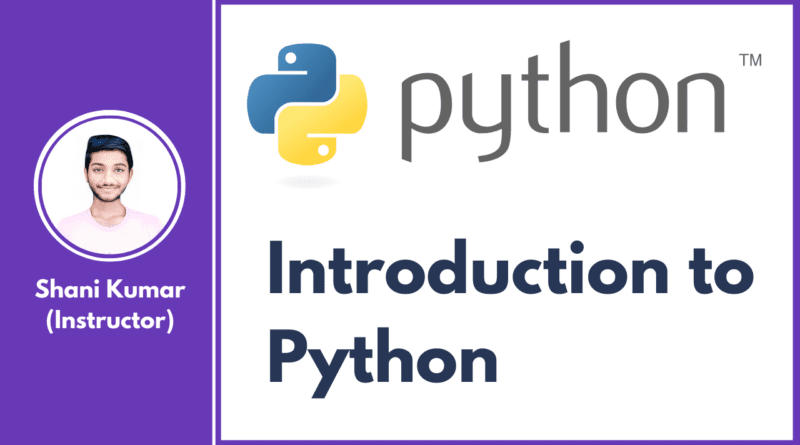01. Introduction to Python | Python Mastery Full Course
What is Python ?
Python is a high-level, versatile, and interpreted programming language. Created by Guido van Rossum and first released in 1991, Python has since gained immense popularity in the world of programming due to its simplicity, readability, and the wide range of applications it supports.
A Brief History of Python
Python’s story begins in the late 1980s when Guido van Rossum, a Dutch programmer, decided to create a language that would emphasize code readability and enable developers to express concepts in fewer lines of code than other languages. Guido released the first version of Python (Python 0.9.0) in February 1991. The name “Python” was inspired by his love for the British comedy group Monty Python.
Over the years, Python underwent several major revisions and updates, with Python 2 and Python 3 being the most significant. Python 2, released in 2000, was widely adopted, but it had some design flaws that made it challenging to maintain and extend. Python 3, introduced in 2008, addressed these issues, although the transition from Python 2 to Python 3 was not seamless due to backward-incompatible changes.
Today, Python is thriving and continues to evolve. It has a large and active community of developers who contribute to its growth and maintain a vast ecosystem of libraries and frameworks, making it one of the most powerful and versatile programming languages available.
Python’s Key Features
1. Readability and Simplicity
One of Python’s most prominent features is its clean and easily readable syntax. Python code is often described as “executable pseudocode” because it closely resembles human language. This readability reduces the barrier to entry for newcomers and makes it easier for developers to understand and maintain code, even as projects grow in complexity.
2. Versatility
Python is a general-purpose language, which means it can be used for a wide range of applications, including web development, data analysis, machine learning, scientific computing, automation, and more. Its versatility is one of the reasons why Python is so popular among developers in various domains.
3. Extensive Standard Library
Python comes with a comprehensive standard library that contains modules and packages for performing a wide array of tasks. Whether you need to work with files, handle network connections, or parse XML data, Python’s standard library likely has a module that can simplify your work. This rich library ecosystem saves developers time and effort.
4. Cross-Platform Compatibility
Python is available for major operating systems, including Windows, macOS, and various flavors of Linux. This cross-platform compatibility ensures that your Python code can run on virtually any system without modification, making it highly portable.
5. Strong Community and Third-Party Libraries
Python boasts a vast and active community of developers. This community has created an extensive ecosystem of third-party libraries and frameworks that expand Python’s capabilities. For example, libraries like NumPy and pandas are essential for data science, while Django and Flask are popular web frameworks.
6. Open Source and Free
Python is open source, meaning it is freely available for anyone to use, modify, and distribute. This open nature has fostered a collaborative environment where developers can contribute to the language’s development and improvement.
What you can do after learning python ?
After learning Python, you have a wide range of possibilities and opportunities to explore, both in terms of personal projects and professional development. Here are some of the many things you can do after acquiring Python programming skills:
1. Web Development
You can use Python to build websites and web applications. Popular web frameworks like Django and Flask make web development in Python efficient and enjoyable.
2. Data Analysis and Visualization:
Python is widely used in data science. You can analyze and manipulate data using libraries like NumPy and pandas, and create insightful visualizations with Matplotlib, Seaborn, or Plotly.
3. Machine Learning and AI:
Python is the language of choice for many machine learning and artificial intelligence projects. Libraries such as TensorFlow, PyTorch, and scikit-learn provide powerful tools for developing and deploying machine learning models.
4. Scientific Computing:
Python is used extensively in scientific research for tasks like simulation, modeling, and data analysis. Libraries like SciPy and SymPy cater to scientific computing needs.
5. Game Development:
While not as common as languages like C++ in the game development industry, Python has libraries like Pygame that allow you to create 2D games and prototypes.
6. Automation and Scripting:
Python is excellent for automating repetitive tasks and scripting. Whether it’s automating file operations, managing data, or streamlining workflows, Python’s simplicity and readability make it a powerful tool for automation.
7. Desktop Applications:
You can create cross-platform desktop applications using frameworks like Tkinter, PyQt, or Kivy. These tools allow you to build user-friendly applications with graphical user interfaces (GUIs).
8. IoT (Internet of Things):
Python is suitable for IoT projects due to its simplicity and the availability of libraries like MicroPython. You can program microcontrollers and devices to perform various tasks.
9. Blockchain Development:
If you’re interested in blockchain technology and cryptocurrencies, Python has libraries like Web3.py for interacting with Ethereum and other blockchain platforms.
10. Cybersecurity and Ethical Hacking:
Python can be used for both offensive and defensive cybersecurity tasks. Ethical hackers often use Python for vulnerability assessment, penetration testing, and writing security tools.
11. Database Management:
Python can be used to interact with various databases, including SQL databases (e.g., SQLite, MySQL) and NoSQL databases (e.g., MongoDB). You can build database-driven applications or perform data migrations and maintenance.
12. Automation of Administrative Tasks:
Python can be used to automate system administration tasks, such as managing servers, configuring networks, and monitoring systems.
Why Learn Python ?
Learning Python is a highly advantageous endeavor for several compelling reasons:
1. Ease of Learning: Python is renowned for its simplicity and readability. Its syntax resembles plain English, making it an ideal choice for beginners. Learning Python is less intimidating compared to languages with complex syntax.
2. Versatility: Python is a general-purpose programming language, meaning it can be applied in various domains. You can use it for web development, data analysis, machine learning, scientific computing, automation, game development, and more. This versatility means you can adapt your Python skills to different career paths or personal projects.
3. High Demand: Python developers are in high demand across industries. Many organizations and startups are using Python for various applications, leading to a robust job market for Python programmers. Learning Python can open up numerous career opportunities.
4. Thriving Ecosystem: Python has a vast ecosystem of libraries and frameworks that facilitate development. These include Django and Flask for web development, NumPy and pandas for data analysis, TensorFlow and PyTorch for machine learning, and many more. These libraries save developers time and effort.
5. Community Support: Python boasts an active and welcoming community of developers. This community is a valuable resource for learning, troubleshooting, and collaborating on projects. Python’s open-source nature encourages community contributions and knowledge sharing.
6. Cross-Platform Compatibility: Python is available for major operating systems, ensuring that your Python code can run on various platforms without modification. This cross-platform compatibility makes Python a versatile choice.
7. Interdisciplinary Applications: Python is used extensively in fields like data science, artificial intelligence, finance, biology, and more. Learning Python can enable you to work on interdisciplinary projects and explore different domains.
8. Rapid Prototyping: Python’s simplicity and readability make it an excellent language for rapid prototyping. You can quickly turn ideas into working prototypes, which is essential for innovation and product development.
9. High-Level Language: Python abstracts many low-level technical details, allowing you to focus on problem-solving rather than wrestling with technical complexities. This makes it an attractive choice for beginners and experienced programmers alike.
10. Job Security: As Python continues to gain popularity and finds applications in various industries, acquiring Python skills can provide job security. The demand for Python developers is expected to remain strong in the foreseeable future.
11. Freelancing and Entrepreneurship: Python skills can empower you to work as a freelancer, taking on diverse projects and clients. Additionally, if you have an entrepreneurial spirit, Python can help you develop prototypes and products for your startup.
12. Teaching and Education: Learning Python also opens up opportunities to teach and educate others. You can share your knowledge through tutorials, courses, or by becoming an educator.





Excellent blog right here! Also your web site quite a bit up fast!
What web host are you using? Can I get your associate link on your host?
I wish my website loaded up as quickly as yours lol